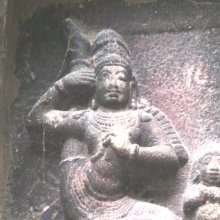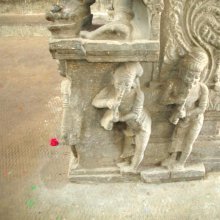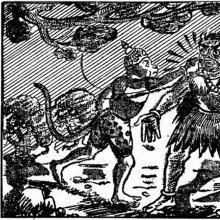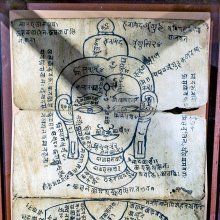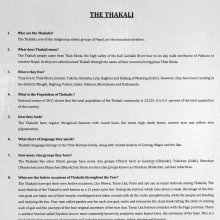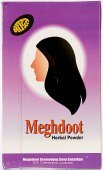Cheek: 2 definitions
Introduction:
Cheek means something in Hinduism, Sanskrit. If you want to know the exact meaning, history, etymology or English translation of this term then check out the descriptions on this page. Add your comment or reference to a book if you want to contribute to this summary article.
Images (photo gallery)
In Hinduism
Natyashastra (theatrics and dramaturgy)
Source: Shodhganga: Elements of Art and Architecture in the Trtiyakhanda of the Visnudharmottarapurana (natya)1) The Cheeks refers to one of the minor Body Parts (belonging to the Face) with which are associated various gestures and expressions (in Sanskrit Dramas), as conveyed through Āṅgikābhinaya: one of the four divisions of Abhinaya or “ways to convey or represent one’s emotion to others”, according to the Nāṭyaśāstra and the Viṣṇudharmottarapurāṇa, an ancient Sanskrit text which (being encyclopedic in nature) deals with a variety of cultural topics such as arts, architecture, music, grammar and astronomy.—The āṅgikābhinaya includes the histrionic representation of the limbs which is simply known as physical gestures. The upāṅgas denote different parts of the Face. These are also six in numbers viz., eyes, eyebrows, nose, lower lip, cheeks and chin.
2) The Cheek is associated with Mṛgaśīrṣa-hasta: one of the twenty-two Single-hand Gestures (in Indian Dramas) (known as asaṃyuktahastas).—The word mṛgaśīrṣa is the union of two words viz., mṛga and śīrṣa. The word mṛga means deer and śīrṣa means head. So, it can be said that the hand posture which is called mṛgaśīrṣa identifies a posture that looks like the head of a deer. [...] In the Abhinayadarpaṇa, the mṛgaśīrṣa-hasta posture is used to denote various things. This book states that this posture is used to show woman, cheek, wheel, limit, terror, quarrel, attire and to call someone or the beloved, the lute, foot massage, female organ, holding umbrella etc.

Natyashastra (नाट्यशास्त्र, nāṭyaśāstra) refers to both the ancient Indian tradition (shastra) of performing arts, (natya—theatrics, drama, dance, music), as well as the name of a Sanskrit work dealing with these subjects. It also teaches the rules for composing Dramatic plays (nataka), construction and performance of Theater, and Poetic works (kavya).
Shilpashastra (iconography)
Source: Shodhganga: Elements of Art and Architecture in the Trtiyakhanda of the Visnudharmottarapurana (shilpa)The Cheek is denoted by the Sanskrit term Gaṇḍa, and represents one of the various body parts whose Measurements should follow the principles of ancient Indian Painting (citra), according to the Viṣṇudharmottarapurāṇa, an ancient Sanskrit text which (being encyclopedic in nature) deals with a variety of cultural topics such as arts, architecture, music, grammar and astronomy.—In the third part of the Viṣṇudharmottarapurāṇa, chapters 35th to 43rd are dedicated to the Painting of different portraits of different kinds of men and women. The measurement of almost all the body parts that should be maintained in a picture have been presented here. For example, the Cheek (gaṇḍa) should be 12 aṅgulas.

Shilpashastra (शिल्पशास्त्र, śilpaśāstra) represents the ancient Indian science (shastra) of creative arts (shilpa) such as sculpture, iconography and painting. Closely related to Vastushastra (architecture), they often share the same literature.
See also (Relevant definitions)
Starts with: Cheekatikoorathuppa, Cheekatimraaku, Cheekengally, Cheekengavally, Cheeky bugger.
Full-text (+430): Kapola, Gandasthala, Ganda, Galla, Kapolakasha, Gallacaturi, Kapolaphalaka, Gandaphalaka, Gandapali, Gandadesha, Galathem, Gallapurana, Kapolaraga, Phulla, Gandabhitti, Gandashaila, Gad, Kandala, Phalaka, Ubbugenne.
Relevant text
Search found 135 books and stories containing Cheek; (plurals include: Cheeks). You can also click to the full overview containing English textual excerpts. Below are direct links for the most relevant articles:
Vinaya Pitaka (1): Bhikkhu-vibhanga (the analysis of Monks’ rules) (by I. B. Horner)
Manasara (English translation) (by Prasanna Kumar Acharya)
Chapter 63 - The lion (siṃha-lakṣaṇa)
Chapter 18 - The general features of edifices (vimāna-lakṣaṇa)
Chapter 51 - The Triad (trimūrti: Brahmā, Viṣṇu, and Maheśa/Śiva)
Sweet Rice Cakes < [March 1943]
‘The Lotus’-An Examination < [April - June 1974]
Marpessa < [March 1944]
Mahabharata (English) (by Kisari Mohan Ganguli)
Section CI < [Rajadharmanusasana Parva]
Section XIX < [Bhagavat-Gita Parva]
Section CXVII < [Rajadharmanusasana Parva]
Sushruta Samhita, volume 1: Sutrasthana (by Kaviraj Kunja Lal Bhishagratna)
Chapter XVI - Puncturing and Bandaging the ear
Chapter XVIII - Poulticing and bandaging of wounds
The civilization of Babylonia and Assyria (by Morris Jastrow)
Related products
